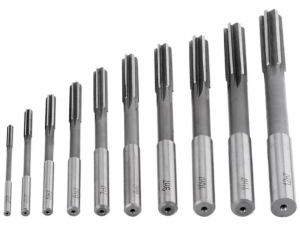Reaming is a common turning operation, which can be done on CNC lathe. To better understand the reaming process, we’ll explore the reaming tool (reamer), difference between reaming and boring, as well as problems in reaming, to avoid errors in advance.

What is Reaming Process?
Reaming is a process of enlarging the previously drilled holes in the workpiece. The purpose of reaming is for widening the opening of the hole, to produce circular hole with right diameter, accurate size and smooth sides.
What is a Reaming Tool?
The reaming operation should be completed with the reaming tool, which is called reamers. Reamer is a kind of rotary cutting tool used in metalworking, and has different precision. The precision reamers are used to achieve a much high level of accuracy and smoothness of the CNC turned parts, while non-precision reaming tools usually only for removing burrs and simple enlargement. The reamer is supported by the tailstock during the reaming on the lathe.
Types of Reamers
– Adjustable hand reamer
– Straight reamer
– Hand reamer
– Machine reamer
– Rose reamer
– Shell reamer
– Tapered reamer
– Combination reamer
What are the Differences Between Reaming and Boring?
Drilling, boring and reaming are three related processes, they have lots of similarities, for example, all of them are adopted to produce a hole in metalworking, while their differences make each process used in difference applications. Here we mainly discussed the difference between reaming and boring.
1.Uses or Purposes
Reaming is primarily for finishing the drilled holes, to improve dimensional accuracy, precision and tolerance level.
Boring is mainly used to enlarge the diameter or convert a cylindrical hole into a taper hole.
2.Cutting Tool
The reaming tool is called reamer, which is multi-point.
The boring tool is boring bar, which is single point.
3.Application
Small holes or deeps holes are usually reamed.
Boring is more suitable for large holes.
4.Capacity
Reamer can be regarded as a forming cutter, it can only ream a hole of specific size.
Boring bar is more flexible, the size can be arbitrarily adjusted to the desired option.
5.Surface Quality
Reaming can provide better surface finish and accuracy than boring.
6.Removed Material
Boring removes more materials than reaming.
Problems and Causes in Reaming
There are many problems or challenges we may meet during the reaming process, whether you execute reaming on CNC lathe, milling machines or others, proper tools and settings should be chosen.
1.Oversized diameter
Causes: the outer diameter of designed reamer is oversized; the reamer edge has burr; too high cutting speed; improper feed or remaining amount; wrong cutting fluid; inappropriate Lead Angle; the reamer is bent; etc.
2.Poor circularity
Causes: too long reamer; vibration or chatter; too small Lead Angle; the reamer edge is too narrow; there are notches and cross holes on the surface of the inner hole; over tight clamping of the thin-wall parts resulting in deformation; the spindle bearing is loose; etc.
3.High roughness
Causes: too high cutting speed; improper cutting fluid; the tool edge is not sharp; rough tool surface; local area has not been reamed; the chip removal is smooth; the reamer is excessively worn; burr or chipping on the edge; etc.
4.Low service life of reamer
Causes: inappropriate tool material; the reamer is burned during grinding; the cutting fluid does not flow smoothly to the cutting area; too high surface roughness; etc.
Tips for Reaming Process
– Use sharp reamers
– Prevent the processing area from dust
– Use quality chuck
– Make sure cutting fluid reaches the cutting edge
– Ensure reaming tool overhang from the spindle
– Avoid blockage
– Keep proper cutting speed and angle
– Choose reamer material according to workpiece material





